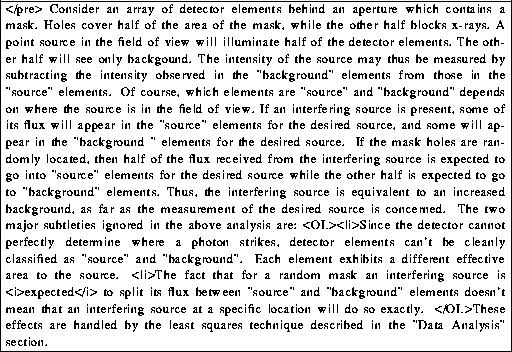
The great complex behavior of compact galactic X-ray sources complicates their study. Since these objects are highly variable, and exhibit a multiplicity of "states", it is often impossible to anticipate when a desired observation can be performed. "Transient" objects appear without warning and may be detectable for only a short period of time. These difficulties can be reduced by an instrument which can monitor a large number of objects simultaneously, or nearly so.
The function of an "All Sky Monitor" is to record a photometric history of known objects, and to detect and locate transient objects. The classic techniques of this field are the pinhole camera and the scanned slat collimator. For both of these approaches, there is an unfortunate tradeoff between spatial resolution and "photon starvation": a high resolution instrument will capture very few photons. The multiple pinhole approach avoids this problem, but designs based on the Uniformly Redundant Array (URA) principle tend to be difficult to build and require a large telemetry bandwidth.
The All Sky Monitor (ASM) for the X-ray Timing Explorer (XTE) avoids these problems. It uses the multiple pinhole approach to avoid photon starvation for good photometric capability together with good resolution and an excellent capability for locating transients. While the XTE ASM doesn't have the ideal imaging qualities of URA based designs, it is simpler to build and requires a modest telemetry bandwidth; since the ASM is intended for detection, location, and photometry of discrete, point sources, imaging is of secondary importance.
